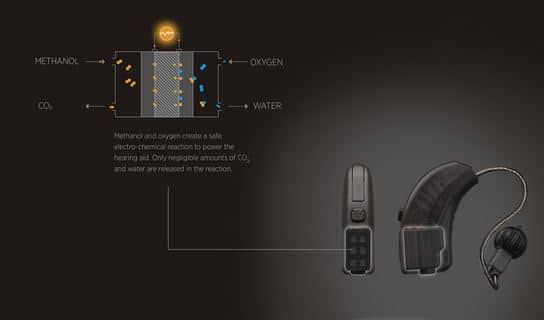At this year’s Consumer Electronics Show (CES) in Las Vegas, Widex has been named a Best of Innovation Awards Honoree for its new Evoke hearing aid featuring revolutionary fuel cell technology, Widex Energy Cell.
The new fuel cell technology represents an industry-first and according to the company, the new hearing aids utilize the world’s smallest commercially available fuel cell. The hearing aids are said to “allow users to re-energize their hearing aids off the grid in just 20 seconds”.
“With Widex Evoke featuring Widex Energy Cell technology, the world will finally get to see its first hearing aid powered by fuel cell technology. Most hearing aids today use batteries or battery chargers connected to power outlets. Our new hearing aid will require neither. This is exciting new technology that will be hassle free for the user while providing superior sound quality and app control that makes the hearing aid easy to manage in any setting.”
–Jeff Geigel, President, Widex USA
In addition to the CES award, the new hearing aid was also honored with a Red Dot 2018 ‘Best of the Best’ Award for Design Concepts and is exhibited in the Red Dot museum in Singapore.
https://www.youtube.com/watch?v=XmDb7f8vUsA&feature=youtu.be
Fuel Cell Power in a Hearing Aid: How Does it Work?
WIDEX ENERGY CELL is the Widex technology based on a miniature fuel cell. Widex has developed a refill unit in collaboration with the Danish Technological Institute, and with financial support from Innovation Fund Denmark.
“Together we have created a small fuel cell that can fit inside a hearing aid without compromising performance and durability. The fuel cell powers the hearing aid through a safe electrochemical reaction using oxygen and methanol. The only waste from this reaction is a small amount of water and carbon dioxide”
–Leif Højslet, Director at DTI
Availability
According to the announcement, the new fuel-cell powered hearing aids will be available in summer of 2019.








A great invention if it can improve sound quality, as boasted by its CEO. What improvement does he mean? Is it just a sales pitch?
I see a useful advantage. The creation of water as a byproduct may help the parched environment!
Jay Muhury.
Auditory Researcher.
HAD.
If the brain doesn’t process words as in the elderly, how can this help the hearing impaired? In a Neuro sensory hearing loss where the small hair-like sensors are no longer capable of processing sound, would this technology be able to overcome the loss?